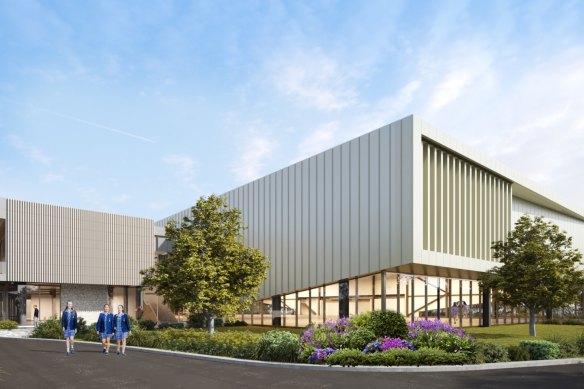By Noel Towell
The federal education minister is demanding answers about the public funding of an exclusive Melbourne private school after The Age revealed the school was spending $85 million on a new sports complex.
The high-fee Presbyterian Ladies College in Burwood gets thousands of dollars more in federal money per student each year than many of Victoria’s top private schools under the Commonwealth’s complex funding formula.

A concept drawing of Presbyterian Ladies College’s new Sports Aquatic and Fitness Centre.Credit: ADCO Constructions
But after the price tag for the college’s aquatic and sports complex was revealed by The Age last week, Education Minister Jason Clare ordered his department to review the socioeconomic assessments underpinning the $9.2 million the school received from Canberra in 2022.
Commonwealth funding per student at the 150-year-old school came to $6285 that year, 55 per cent higher than the average funding of $4060 per student at the rest of Victoria’s top 22 private schools. The above-average funding for PLC’s 1471 students amounted to about $3.25 million in income for the college in 2022.
Of the state’s elite private schools, only Geelong Grammar – where King Charles studied for six months when he was a teenager, and where fees topped $50,000 this year – and upmarket Catholic school Genazzano came close to PLC’s per-student funding from Canberra, with $5514 and $5220 respectively.
Commonwealth funding per child at Victoria’s government schools – which receive most of their funding from the state – averaged $3200 in 2022.
The higher-than-average federal funding for PLC, where year-12 fees topped $38,000 this year, was based on a “capacity to contribute” (CTC) score – determined by the Education Department – of 103, commensurate with school families earning just above-average incomes.
But nearly 80 per cent of PLC families are in the top quarter of income earners, and the college sits in the top 1 per cent of schools on the government’s Index of Community Socio-Educational Advantage.
Clare said he had ordered his department to review PLC’s CTC score.
“I have asked my department to review the CTC score for this school and how it was arrived at,” the minister said.
A departmental spokesman said: “The work is under way.”
PLC, which has consistently said its new $85 million sports complex is being funded by cash reserves, private fundraising and non-government grants, said last week: “PLC … receives funding in accordance with the current schooling resource standard.”
Economist Adam Rorris, who managed the federal government’s school resourcing taskforce and has advised the World Bank on the economics of education, said Australia’s “highly inefficient” school funding system had led to a situation where the country’s richest schools had more money than they needed.
“What they are doing is using clearly inadequate school wealth assessment formulas to justify providing additional funding to schools that have $85 million in the bank for capital expenditures that are clearly superfluous to a decent quality education,” Rorris said.
“It can be dressed up any which way any government wants, but they’re spending Australian taxpayers’ money on overfunded wealthy private schools when we don’t have air conditioning in public schools in the western suburbs of Melbourne, Sydney and other capital cities.”
The review of PLC’s funding comes as Clare remains deadlocked with his Victorian counterpart, Ben Carroll, over a new funding deal for the state’s government schools.
Carroll is adamant that Victoria will not follow the example of Tasmania, which last week agreed to sign up to a new 10-year agreement for Canberra to lift its funding commitment to 22.5 per cent of the schooling resource standard measure, with the Tasmanian government to pay 77.5 per cent.
Tasmania joins WA and the Northern Territory in agreeing to Clare’s offer, but the other states and territories, led by Victoria and NSW, continue to hold out for 25 per cent of the schooling resource standard from the Commonwealth.
Carroll’s office told The Age last week that the nation’s public schools would be underfunded by more than $600 million a year under the Commonwealth’s proposal, while private schools would remain overfunded by nearly $3 billion.
“Victorian government students shouldn’t have to go without adequate Commonwealth investment in their education,” Carroll said.
The Morning Edition newsletter is our guide to the day’s most important and interesting stories, analysis and insights. Sign up here.